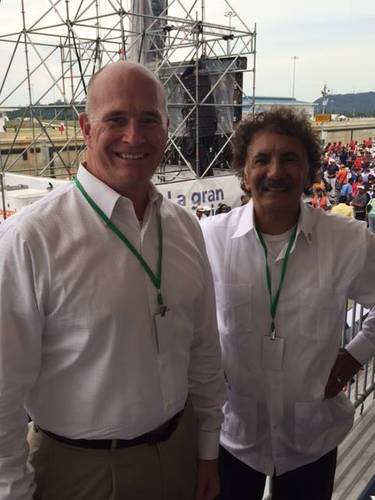Just two weeks ago, the world watched as the first commercial vessel, M/V COSCO SHIPPING PANAMA, successfully navigated the Panama Canal’s new expanded locks. The inaugural event was broadcast live to a worldwide audience as the Panamanians in attendance cheered and waved flags in celebration of their country’s newest engineering marvel.
Along with numerous heads of state and with representatives from many nations, I had the opportunity to attend the ceremony to congratulate the Panama Canal Authority (ACP) and the citizens of Panama on a successful expansion. Given that two out of every three ships that transit the Panama Canal are headed to or from the United States, our nation is the largest market served by the canal, so we have a strong interest in the canal’s long-term success. The project to build a third set of expanded locks doubled the canal’s capacity and nearly tripled the size of ships that can transit through it.
In this new age of increasingly larger vessels - necessary in the ultra-competitive global shipping market - the opening of the new locks should ensure the canal’s viability for years to come.
Likewise, we will potentially see cost savings from this expansion for shippers – primarily for imports reaching our shores on the larger container ships now able to transit through the canal. The expected lower transportation costs could also boost U.S. bulk commodity and energy exports to Asian and Pacific destinations.
However, for the U.S. to take full advantage of the enhanced economies of scale promised by the expanded Panama Canal, we have much work of our own to do. We must expand and, in many cases, deepen our own ports and waterways, raise bridges and modernize our aging domestic maritime shore side infrastructure. Many U.S. East and Gulf Coast ports have already completed expansion and deepening projects, invested in larger ship-to-shore cranes in order to accommodate the larger ships expected to utilize the expanded Canal. There are similar upgrades underway at other ports, including channel deepening, berth expansions, crane purchases, truck gate improvements and construction of intermodal facilities to service the ports.
The Maritime Administration has been focusing on helping our domestic maritime partners identify areas for improvement while providing expertise and a variety of funding streams, grants and loans, to ensure the industry’s long-term viability. A healthy U.S. Merchant Marine and maritime industry is essential for our national security and economic health. Given the potential effects on U.S. maritime commerce from the Panama Canal expansion through increased international trade and more efficient routing of larger ships servicing the East and Gulf Coast of the United States, we will be closely monitoring the trends that develop as a result of this historic expansion.
The expanded canal is a major investment in Panama’s and the region’s future and should yield commercial benefits here at home. Already, more than 200 vessels have booked reservations to transit the new expanded locks. So as the world marvels at the widening of this new waterborne superhighway, we can look to the potential resurgence of our nation’s maritime industry, and the deepening of our 100-year-old partnership and friendship with the Republic of Panama.
The Author
Paul “Chip” Jaenichen was appointed by President Obama and has served as Maritime Administrator since July 25, 2014. He previously served as both Deputy and Acting Maritime Administrator from July 2012 to July 2014.
Captain Jaenichen was a career naval officer, who retired after 30 years as nuclear trained Submarine Officer in the U.S. Navy. His final assignment was as Deputy Chief of Legislative Affairs for the Department of the Navy from October 2010 to April 2012. He served as Commanding Officer of USS ALBANY (SSN 753) from 1999 to 2002 and as Commander, Submarine Squadron ELEVEN in San Diego from 2007 to 2008. His shore tours included assignments as Director, Submarine/Nuclear Officer Distribution where he was responsible for over 5200 officers; as Officer-in-Charge of Moored Training Ship 635, one of two nuclear powered training platforms in Charleston, S.C., where he was responsible for more than 1,200 officer and enlisted operators; and as Chief, European and North Atlantic Treaty Organization (NATO) Policy Division on the Joint Staff where he was responsible for military-to-military engagement with all 26 NATO member nations.
Captain Jaenichen’s hometown is Brandenburg, Ky. He earned a Bachelor of Science in Ocean Engineering from the U.S. Naval Academy and a Masters in Engineering Management from Old Dominion University.
(Source: U.S. Dept. of Transportation Fast Lane Blog)


















